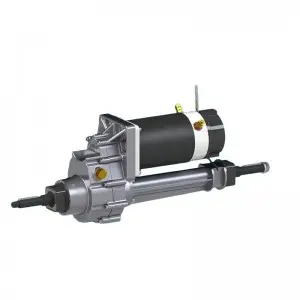Introduction
In the rapidly evolving world of automotive technology, electric transaxles have emerged as a critical component in electric and hybrid vehicles. These transaxles are responsible for transmitting power from the electric motor to the wheels, ensuring efficient and reliable operation. One crucial process that significantly impacts the performance and durability of electric transaxles is heat treatment. This blog post delves into the role of heat treatment in electric transaxles, exploring its various aspects, benefits, and industry implications.
Understanding Electric Transaxles
Electric transaxles are integrated systems that combine the functions of a traditional transmission and differential. They are designed to handle the unique power delivery characteristics of electric motors, which typically offer instant torque and a wide range of operating speeds. The key components of an electric transaxle include gears, shafts, bearings, and housings, each playing a vital role in transmitting power efficiently.
The Heat Treatment Process
Heat treatment is a controlled process that alters the microstructure and mechanical properties of metals. It involves heating and cooling the material under specific conditions to achieve desired outcomes such as increased hardness, strength, and wear resistance. The heat treatment process typically consists of several steps, including:
Annealing: This initial step involves heating the metal to a specific temperature and then slowly cooling it. Annealing helps to relieve internal stresses, improve machinability, and refine the microstructure.
Normalizing: In this process, the metal is heated above its transformation range and then air-cooled. Normalizing refines the grain structure and improves the uniformity of properties throughout the component.
Quenching: This is a rapid cooling process where the heated metal is immersed in a quenching medium such as oil, water, or polymer. Quenching hardens the metal by transforming its microstructure, typically forming martensite.
Tempering: After quenching, the metal is reheated to a specific temperature and then cooled at a controlled rate. Tempering reduces brittleness while maintaining desired hardness and improving toughness and ductility.
Role of Heat Treatment in Electric Transaxles
Enhancing Mechanical Properties
Heat treatment significantly improves the mechanical properties of the components used in electric transaxles. By refining the microstructure, heat treatment increases hardness, strength, and wear resistance. For example, gears subjected to heat treatment can withstand higher loads and resist deformation and fatigue failure, ensuring smooth power transmission and extended service life.
Improving Dimensional Stability
Electric transaxle components must maintain precise dimensions to ensure proper meshing and alignment. Heat treatment minimizes internal stresses and distortion, leading to improved dimensional stability. This is crucial for maintaining the accuracy of gear teeth profiles and reducing noise during operation.
Increasing Wear Resistance
The hardened surface layer resulting from heat treatment enhances the wear resistance of components such as gears and bearings. This reduces friction and minimizes surface damage during continuous operation, extending the service life of the transaxle and reducing maintenance costs.
Ensuring Consistency and Control
Heat treatment processes can be precisely controlled to achieve consistent properties across batches of components. This ensures uniform performance and quality, which is essential in the automotive industry where reliability and precision are paramount.
Addressing Material Challenges
Different materials used in electric transaxles, such as steel, aluminum, and forged parts, have varying responses to heat treatment. Understanding these responses allows manufacturers to optimize the heat treatment process for each material, ensuring maximum benefits while minimizing potential drawbacks.
Heat Treatment in the Electric Transaxle Industry
Current Industry Practices
In the electric transaxle industry, heat treatment is widely employed to enhance the performance and durability of components. Manufacturers carefully select appropriate heat treatment processes based on the specific requirements of each component, considering factors such as load conditions, operating speeds, and environmental factors. Advanced simulation software and finite element analysis are often used to predict and optimize heat treatment outcomes, ensuring optimal mechanical properties and minimizing distortion.
Market Trends and Demand
The growing demand for electric vehicles has driven significant advancements in electric transaxle technology and heat treatment processes. As manufacturers strive to improve vehicle efficiency and performance, the need for high-quality, durable transaxle components has increased. This has led to a focus on developing more efficient heat treatment methods and exploring new materials that can benefit from heat treatment to meet the evolving demands of the electric vehicle market.
Research and Development
Ongoing research in heat treatment focuses on improving process efficiency, reducing energy consumption, and enhancing environmental sustainability. Researchers are exploring alternative quenching media, optimizing temperature profiles, and developing new alloy compositions to achieve superior mechanical properties with minimal environmental impact. Additionally, advancements in automation and process control are enabling more precise and consistent heat treatment outcomes.
Conclusion
Heat treatment plays a vital role in the manufacturing and performance of electric transaxles. By enhancing mechanical properties, improving dimensional stability, increasing wear resistance, and ensuring consistency, heat treatment contributes to the reliability, efficiency, and longevity of electric transaxles. As the automotive industry continues to evolve, the importance of heat treatment in electric transaxle manufacturing will only grow, driving further innovation and development in this crucial process.
Post time: Mar-07-2025


